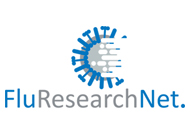Head of Dept. of Infection Genetics
Helmholtz Center for Infectious Research,
University of Veterinary Medicine Hannover,
University of Tennessee Health Science Center
Inhoffenstr. 7
38124 Braunschweig
Phone: +49 (0) 531 6181 1100, Fax:+49 (0) 531 6181 1199
klaus.schughart@helmholtz-hzi.de
Homepage
Research Interests: Our laboratory is studying the genetic factors of the host that are influencing susceptibility or resistance to influenza A infections. For this, we are using the mouse as model system. The value of the mouse model has been demonstrated for recent and historical (1918) influenza A/H1N1 subtypes, as well as the highly pathogenic bird subtype A/H5N1. In our research group, we are characterizing genetic factors that influence the susceptibility of the host to influenza A infections. We are studying different mouse families (genetic reference populations), mutants (knock-out lines) and various influenza subtypes (H1N1, 2009, H1N1, H7N7). After infection, we investigate survival, weight loss, viral load, immune cell infiltrates, histopathology, chemokine/cytokine profiles and changes in gene expression to follow the host response at the molecular, cellular and organism level. So far, our studies revealed a strong influence of the genetic background for the host susceptibility to influenza infections. One resistant and one susceptible mouse strain were studied in detail. The high susceptibility in the DBA/2J mouse strain is caused by high viral loads in infected lungs and a hyper-inflammatory response. The mapping of the susceptible trait in BXD recombinant inbred strains revealed five Quantitative Trait Loci (QTLs) that are currently investigated in more detail. At present, we have initiated a large scale phenotyping program with the novel Collaborative Cross recombinant inbred mouse reference population. We also showed that Rag2, Irf7 and Socs3 knock-out mice were more susceptible to influenza A infection than wild type mice whereas mice carrying a mutation in the Tmprss2 gene were highly resistant against infection with H1N1 virus. In addition, we initiated a large scale systems biology study in which we profiled the changes in gene expression patterns in the lungs of C57BL/6J mice after influenza A infection over a period of 60 days post infection. This data set provides an essential basis for future modeling of the host-pathogen-interactions during influenza infections.
